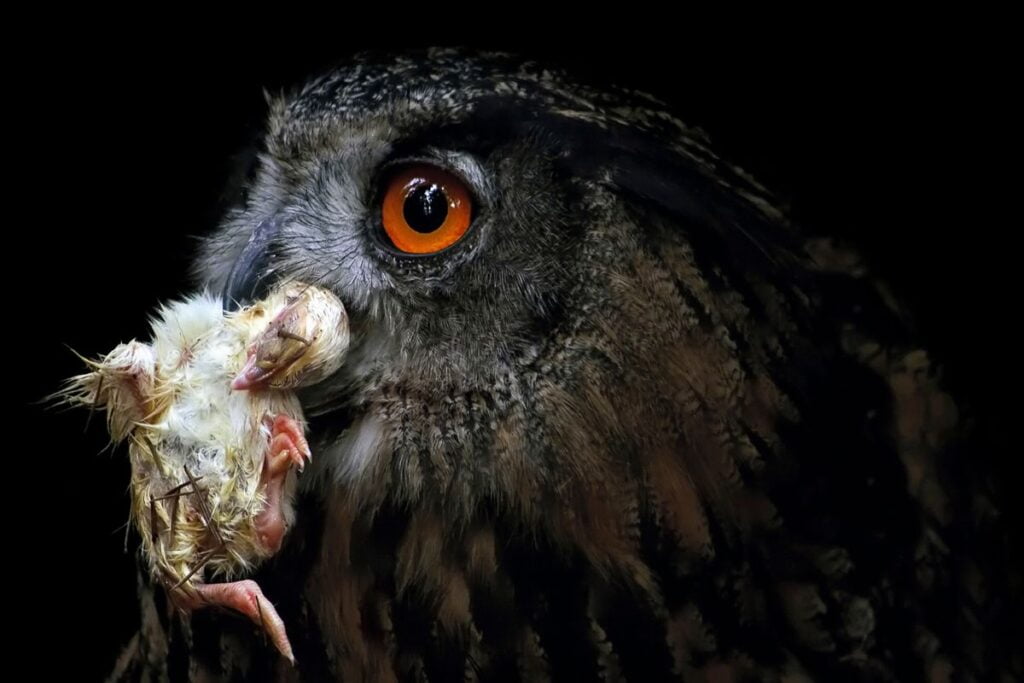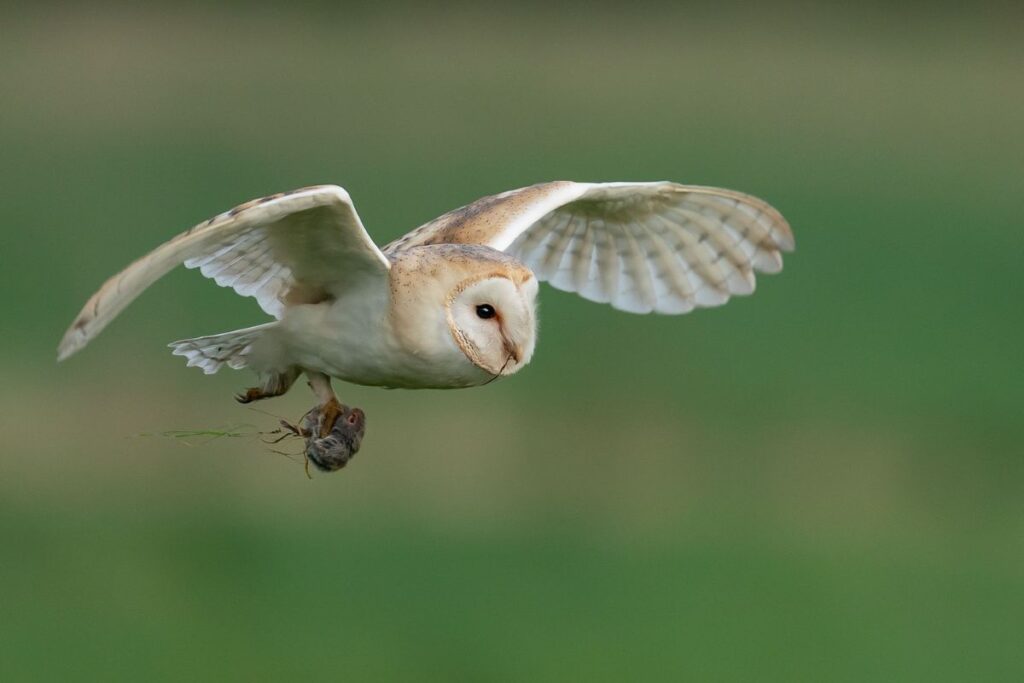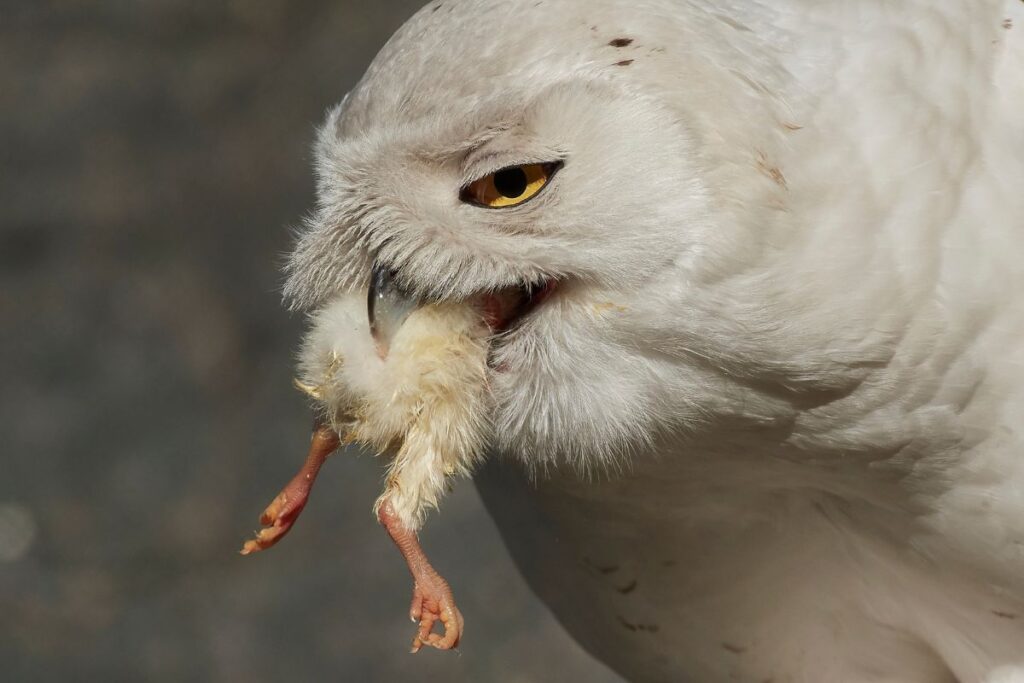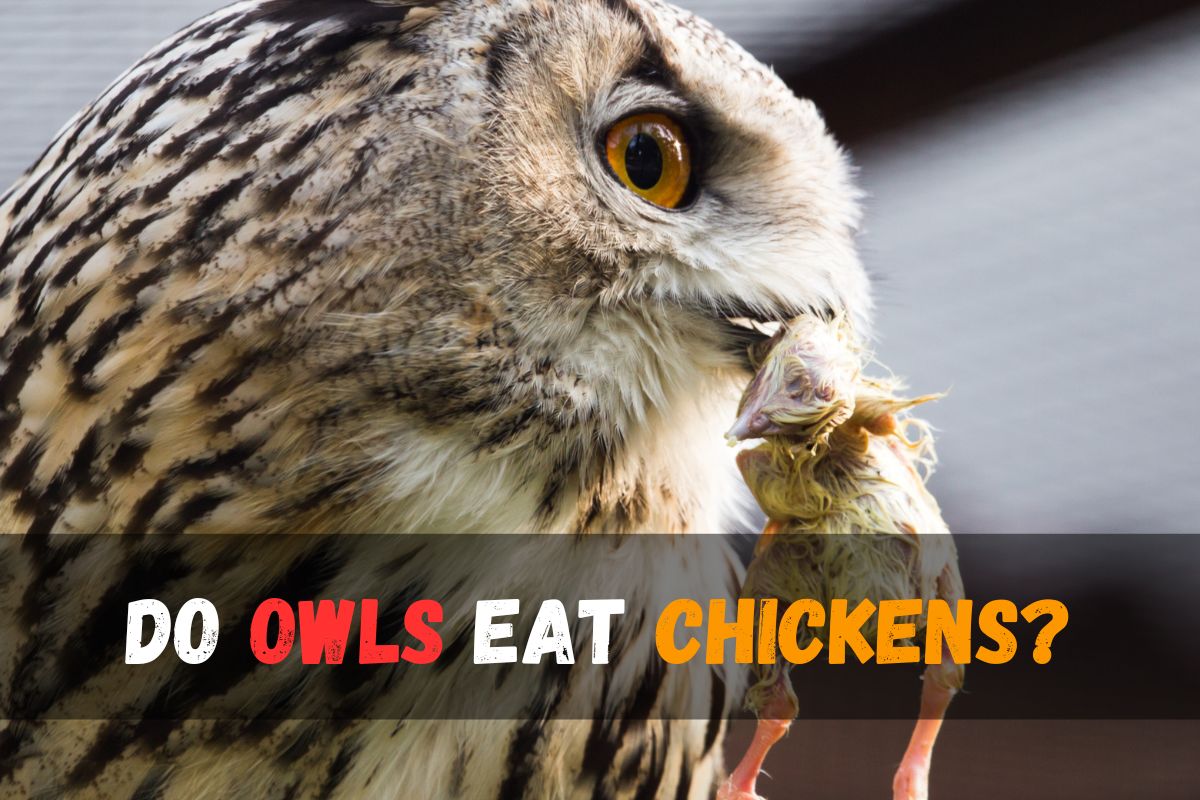Do owls eat chickens?
Owls, as birds of prey, have been a topic of concern for many backyard chicken owners, especially those who keep their chickens in a free-range environment. The question on their minds is, “Do owls eat chickens?” calm your worry, it’s important to know how these amazing animals and the birds in your backyard get along
The dietary habits of owls are indeed diverse, and chickens can sometimes find themselves on the menu. Owls are opportunistic predators, and their food choices are influenced by factors such as location, availability, and the owl’s body weight. When it comes to their diet, owls primarily target small mammals and birds, often considering them a convenient and appetizing option for dinner.
Chickens, residing within a coop or free-ranging, can occasionally attract the attention of owls, especially those living near these majestic birds. Concerns among poultry owners arise when the presence of owls in the vicinity raises questions about the safety of their feathered family members.
Among the various species of owls, the great horned owl stands out as one of the primary threats to backyard chicken owners. Their powerful talons and sharp beaks make them efficient predators, and they are known to prey on a variety of animals, including chickens. This fact might leave you worried about the safety of your poultry.
Do owls attack humans?
How Dangerous Are Owls to Chickens?
Owls can indeed pose a significant threat to chickens, and the level of danger varies based on several factors. Most owl species, including Snowy Owls and the Great Horned Owl, are skilled predators that are not hesitant to swoop down and attack chickens, often biting off their heads. These birds of prey primarily prey on rodents and smaller birds, but they will also target chickens, cats, and even small dogs. Owls are far from slow; they are incredibly fast, and their sharp talons can dig into their prey, making it difficult for chickens to escape.

In some cases, owls have been known to attack humans, leaving them with serious injuries, underlining the inherent danger they pose. The level of danger also depends on the size of the chicken and the specific owl species. Adult chickens are more likely to be targeted by larger owl species, while smaller or younger poultry may be at risk from smaller owls.
To mitigate the danger that owls pose to chickens, it is essential to take preventive measures, such as securing the coop at night and using motion-activated lights to deter owls from approaching. To enhance the safety of your flock and reduce the likelihood of owl attacks, it is advisable to take proactive measures. So, while owls are captivating creatures, their potential threat to chickens should not be underestimated, and precautions should be taken to protect your poultry.
Why Do Owls Bite the Heads off Chickens?
Owls, known for their unique hunting behaviors, exhibit a particular pattern when preying upon chickens. Understanding the reasons behind why they bite the heads of these birds reveals several compelling factors that contribute to this behavior.
Efficient Consumption
Owls have a clever way of ensuring they get the most out of their meal. When they catch a chicken or other prey, they don’t waste time. Instead, they go straight for the head. But why do they do this?
Imagine you’re really hungry, and you have a plate of food in front of you. You want to eat it as quickly as possible because you’re so hungry. Owls feel the same way when they catch something to eat. By biting off the head of a chicken, they can get to the best, most nutritious parts more easily.
The head of a chicken has some really good stuff inside, like the brain and neck muscles. These parts are full of important nutrients and fats that owls need to stay strong and healthy. So, by going for the head first, owls make sure they’re getting the most out of their meal without wasting any time.
It’s like eating your favorite part of a meal first because you know it’s the most delicious and gives you the energy you need. Owls are just being smart about how they eat to stay strong and keep hunting.
Reducing Risk Protecting Owls from Harm
Owls have a smart reason for biting off the heads of chickens: it’s all about staying safe. Imagine if you were an owl, trying to catch a chicken for dinner. Chickens aren’t defenseless; they can peck and use their sharp talons to fight back. That can be dangerous for an owl, as they could get hurt in the process.

So, owls have developed a clever strategy. By targeting the head of the chicken and removing it quickly, they significantly reduce the risk of injury. The head is where the beak and talons are most dangerous. By getting rid of it, owls protect themselves from harm and ensure a safer meal.
Owls’ Clever Hunting Strategies:
Owls are smart hunters, and they have developed clever tactics to catch their prey, including chickens. When owls go after their targets, they aim for specific, vulnerable areas, like the head. This isn’t random; it’s a well-thought-out strategy.
You see, the head is really important to the prey’s survival. By quickly disarming the prey, in this case, biting off the head, owls increase their chances of successfully catching their meal. It’s like they’ve figured out the best way to make sure their dinner can’t fight back. So, when you see an owl biting a chicken’s head off, remember, it’s all part of their clever hunting plan.
Digestible and Nutrient-Rich Parts:
Owls bite off the heads of chickens because it helps them get to the tasty and easily digestible parts. Think of it like owls enjoying their favorite, most delicious part of a meal. The head contains the chicken’s brain and eyes, which are not only yummy but also packed with the nutrients owls need to stay strong and healthy. By going for the head first, owls make sure they get the best part of their meal and don’t waste any time. It’s like biting into the best part of a sandwich first, leaving the crust for later!
How to Keep Your Chickens Safe From Owls
To ensure the safety of your chickens and protect them from owls, follow these essential steps:
1. Secure Coop and Run
This involves constructing a coop with a sturdy, solid roof to prevent owls from swooping in. Additionally, using robust fencing and wire mesh to enclose the run area and burying the wire mesh underground deters digging predators. By implementing these measures, you create a safe and fortified space for your chickens, reducing the risk of owl threats.
2. Lock Up at Night
Locking up at night is a critical safeguard for your chickens’ safety. Since owls are nocturnal predators, ensuring that your chickens are securely inside the coop at dusk is essential. To prevent owl attacks, make certain that latches and locks are positioned out of the reach of these aerial hunters. This proactive measure helps create a secure environment for your chickens during the vulnerable nighttime hours.
3. Motion-Activated Lights
Installing motion-activated lights around your chicken coop and run is an effective strategy to deter owls from approaching. These lights are triggered by movement, so when an owl comes near, the sudden brightness startles them, making them less likely to continue their approach. Motion-activated lights provide an automated and non-invasive way to safeguard your chickens during the night, ensuring their safety without the need for continuous human intervention.
4. Guard Animals
“Guard Animals,” such as dogs, serve as highly effective protectors for your chickens, deterring potential threats like owls and other predators. These animals are known for their instincts to safeguard their territory, making them a valuable asset in keeping your chickens safe. With their presence, they can actively patrol the area and help maintain a secure environment for your poultry. Guard animals offer an additional layer of protection in your efforts to safeguard your flock from nocturnal hunters like owls, contributing to the overall safety and well-being of your chickens.
5. Noise Deterrents
Noise deterrents are an effective method to deter owls from approaching your chicken coop. By setting up devices such as radios and loudspeakers playing loud sounds or distress calls of owls, you create an environment that discourages these nocturnal hunters. The unexpected noise disrupts their hunting patterns and keeps them away from your chickens, contributing to their safety. Noise deterrents are a humane and non-lethal way to protect your poultry while minimizing harm to the owl population in your area.
How Owls Hunt Chickens
Owls employ various tactics and features to effectively hunt chickens. These skilled predators are well-suited for the task. Here’s how owls go about hunting chickens:
Nighttime Attacks:
Owls are primarily nocturnal hunters. They take advantage of the cover of darkness to approach chickens while they are at rest during the night. Owls have exceptional night vision, which gives them a significant advantage over chickens in low-light conditions.
Silent flight:
A remarkable avian adaptation, enables certain birds, such as owls, to move through the air with virtually no sound. This ability is achieved through specialized wing feathers that minimize turbulence and noise during flight. It allows owls to approach their prey stealthily, making them highly effective nocturnal hunters.
Surprise Attacks:
Owls are patient predators. They often perch in trees or on structures near chicken coops, patiently waiting for an opportunity to strike. When the moment is right, they swoop down suddenly and grab a chicken. This surprise attack can catch the chickens off guard, making it difficult for them to escape.
Talons and Beak
Talons and beaks are the formidable tools owls use in their hunting strategy. Owls’ talons are powerful, sharp claws designed for gripping and restraining prey, while their keen beaks can deliver deadly strikes, making them highly effective predators in the avian world. These specialized features make owls skilled and efficient hunters.
FAQ’S
Aren’t Chickens Too Heavy?
While owls are certainly skilled predators, they do have limitations when it comes to the size of their prey. Chickens can vary in size, and smaller breeds are more vulnerable to owl attacks. Larger and heavier chickens may be more challenging for owls to carry away, but they can still pose a threat to them. Owls tend to target chickens that are more manageable in size, which allows them to effectively hunt and capture their prey.
What Are Owls Afraid Of?
Owls, like many other animals, have their natural fears and predators. They may be wary of larger predators such as eagles, hawks, and other raptors, which can pose a threat to them, particularly when competing for food or territory. Owls are generally cautious around humans and can become stressed if approached too closely or disturbed, so it’s important to give them their space. Bright lights, like vehicle headlights or spotlights, can disorient owls due to their sensitive night vision, and sudden loud noises can startle them, disrupting their hunting or resting. Owls also have to be cautious of other nocturnal predators like raccoons and foxes. Additionally, habitat destruction and deforestation can threaten owl populations by disrupting their natural habitat and affecting their ability to find suitable food and nesting sites. Conservation efforts are essential to protect these remarkable birds and their ecosystems.
Do owls eat chicken bones?
Bones are hard and indigestible for owls, and they lack the necessary enzymes and digestive system to break down bone material. After consuming the flesh and other edible parts of their prey, owls regurgitate undigestible components, including bones, in the form of pellets. These pellets are typically composed of the bones, fur, feathers, and other indigestible parts of their meals.

So, while owls do not eat chicken bones or bones of other prey animals, you may find owl pellets near their roosting or nesting sites containing the remains of the bones from their previous meals. These pellets can be studied by scientists to learn more about the owl’s diet and the types of animals they have been hunting.


